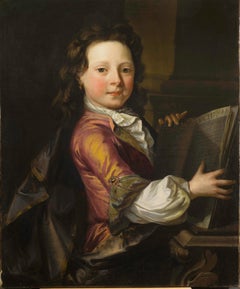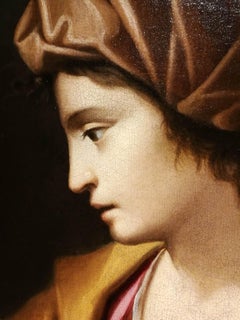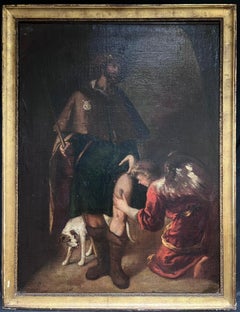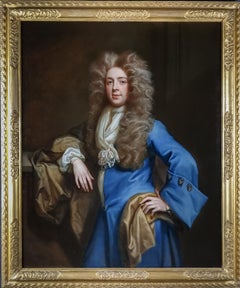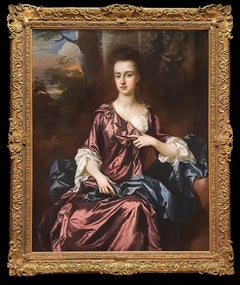John Closterman Portrait Paintings
British, 1660-1711
John Closterman was born in 1660 in Osnabrück, then part of the Holy Roman Empire. Closterman’s father was an artist and would have given his son a basic training. It was not until 1679 when Closterman travelled to Paris and worked under the Court artist François de Troy that he began to hone his skills as a portrait painter. In 1680, following the death of Sir Peter Lely, Closterman arrived in London where he was soon employed by John Riley as a painter of draperies. After the death of Riley in 1691, the demand for Closterman’s works soared and by the late 1690s he appears to have enjoyed a position amongst the most distinguished literary and artistic circles.
In 1696, Closterman was invited to Spain where he was patronsied by the court and painted full-length portraits of Carlos II and Maria Ana of Neuberg. He went from Madrid to Rome where he collected old master drawings and expanded his knowledge of classical antiquities. On his return to England in 1702, his demand amongst the nobility had increased further as a result. Closterman in the last few years of his life took a beautiful mistress who, according to Arnold Houbraken, stole much of his property and then left him. Her departure allegedly precipitated Closterman’s physical and mental decline, he died soon after in 1711.(Biography provided by Peter Harrison Fine Art Ltd)
to
1
1
1
1
Overall Height
to
Overall Width
to
1
1
1
1
1
1
178
100
66
62
1
1
1
1
Artist: John Closterman
Portrait of a Boy, John Closterman, Large English Portrait Art, Old Master
By John Closterman
Located in Greven, DE
John Clostermann
(Osnabrück 1660 - 1711 London)
Portrait of a boy, maybe Charles Hinde
Oil on canvas, 61 x 74,6 cm
John Closterman (also Klosterman) was a portrait painter of the late 17th and early 18th centuries. He primarily portrayed English noblemen and European aristocratic families. His father was already an artist and he trained his son. In 1679 he went to Paris and studied with Francois de Troy. In 1681 he was in London and worked for the artist John Riley, whose studio he took over after his death. In 1696 he was invited to the Spanish court...
Category
17th Century Baroque John Closterman Portrait Paintings
Materials
Canvas, Oil
Related Items
G Negri called Il Boccia Baroque Figurative Painting 17th century oil canvas
By Girolamo Negri called Il Boccia
Located in Florence, IT
Oil on canvas, 62 x 51 cm (without the frame)
Even if on the background there is an attribution to “Francesco Gessi pupil of Guido Reni” by the bolognese art historian Guido Zucchini (dated 1945), recent studies are tending to add it to the corpus of Girolamo Negri called Il Boccia (Bologna 1648-1718) due to lots of similarities with his style (the pale and warm palette chosen, the profile)
The painting represents a lady on profile wearing a brown turban, a yellow clock...
Category
Late 17th Century Baroque John Closterman Portrait Paintings
Materials
Canvas, Oil
Huge 17th Century Spanish Old Master Oil Painting Wounded Pilgrim with Angel
Located in Cirencester, Gloucestershire
The Pilgrim and Angel
Spanish School, 17th Century
oil on canvas, gilt framed
framed: 48 x 37 inches
canvas: 43 x 32 inches
provenance: private collection, Barcelona, Spain
condition...
Category
17th Century Baroque John Closterman Portrait Paintings
Materials
Canvas, Oil
Fine Quality 17th Century Dutch Old Master Oil on Wood Panel Trial of Christ
Located in Cirencester, Gloucestershire
The Trial of Christ
Dutch Old Master, 17th century
oil on panel, unframed
panel: 11 x 7.5 inches
provenance: private collection, England,
Christies auction stencil marks verso
condi...
Category
17th Century Baroque John Closterman Portrait Paintings
Materials
Oil, Wood Panel
17th century English figure painting - Portrait nobleman - Oil on canvas
Located in Varmo, IT
English painter (17th century) - Portrait of a gentleman.
73.5 x 63.5cm.
Oil on canvas, unframed.
Condition report: Canvas applied on panel. Good state of conservation of the pict...
Category
Mid-17th Century Baroque John Closterman Portrait Paintings
Materials
Canvas, Oil
Free Shipping
H 28.94 in W 25.01 in
'Rebekah at the Well', Follower of Luca Giordano, Early 19th Century Figural Oil
Located in Santa Cruz, CA
An early 19th century, figural oil of a young woman with chestnut hair, shown wearing a headscarf and glancing towards the viewers left. A detail from a copy of 'Rebeca at the Well',...
Category
19th Century Baroque John Closterman Portrait Paintings
Materials
Canvas, Masonite, Oil
H 16 in W 13.75 in D 0.13 in
Baroque painter (Italian school) - 18th century figure painting - Saint Peter
Located in Varmo, IT
Italian painter (18th century) - St. Peter.
44.5 x 34cm.
Antique oil painting on canvas, without frame.
Condition report: Lined canvas. Good state of conservation of the pictorial...
Category
Early 18th Century Baroque John Closterman Portrait Paintings
Materials
Oil, Canvas
Free Shipping
H 17.52 in W 13.39 in
Three Angels
By Domenico Piola the Elder
Located in New York, NY
Provenance:
Robert L. and Bertina Suida Manning, New York, until 1996
Private Collection, USA
One of the leading artists in Genoa during the second half of the seventeenth century, Domenico Piola came from a successful family of artists, renowned for their many illusionistic ceiling programs throughout Genoese churches and palaces. A prolific draughtsman and painter, Domenico oversaw an extremely productive studio. In addition to his collaborations with numerous other artists, Domenico also provided many designs for book illustrations and prints that circulated throughout Europe, earning him international exposure and high acclaim in his own day.
As Dr. Anna Orlando has indicated (written communication), the present work is an early work by Piola, datable from the late 1640s. At this time the young artist came strongly under the influence of Castiglione and Valerio Castello, while admiring the works of Giulio Cesare Procaccini. Piola’s works from this period are exuberant and fluid, and the artist’s love of portraying children is evident from the angels and putti that populate both his altarpieces and more intimate paintings.
The present work depicts three angels...
Category
17th Century Baroque John Closterman Portrait Paintings
Materials
Canvas, Oil
17th Century Italian Old Master Fine Portrait of St. Nicholas
Located in Cirencester, Gloucestershire
St. Nicholas of Tolentino (1245-1305)
Italian School, 17th century
oil painting on canvas,
canvas: 10 x 8 inches
provenance: private collection, Germany
Very fine and rare 17th century Italian Old...
Category
17th Century Baroque John Closterman Portrait Paintings
Materials
Oil
H 10 in W 8 in D 0.5 in
Portrait of an English Gentleman "Sir"
Located in Soquel, CA
Portrait of a nobleman by an unknown artist , titled "Sir" on a London label on verso. A man dressed in dark robes with a white collar looks directly at the viewer. Heavy age toning ...
Category
Late 18th Century Baroque John Closterman Portrait Paintings
Materials
Oil, Canvas
Portrait of a Tudor English Gentleman in Fine Ornate Gilt Swept Frame
Located in Cirencester, Gloucestershire
English School, 20th century
painted in an earlier 'Tudor' style
signed oil painting on paper stuck down on board, framed
framed: 32 x 25 inches
board: 25 x 18 inches
provenance: fro...
Category
20th Century Baroque John Closterman Portrait Paintings
Materials
Oil
FINE EARLY 1700'S ITALIAN BAROQUE OLD MASTER - MARY MAGDALENE WITH CHERUBS
Located in Cirencester, Gloucestershire
Artist/ School: Italian School, early 18th century
Title: Mary Magdalene attended by Cherubim
Medium: oil painting on canvas laid on board, framed
Size: painting: 34cm x 49cm
...
Category
Early 18th Century Baroque John Closterman Portrait Paintings
Materials
Oil
Virgin and Child with the Infant Saint John
By Domenico Puligo
Located in New Orleans, LA
A masterful example of Italian Mannerist painting, this exceptional panel was composed by the renowned Florentine painter Domenico Puligo. Alongside Jacopo Pontormo and Rosso Fiorentino, Puligo is remembered as one of the foremost figures of the Mannerist movement that rose to prominence during the 16th century in Florence. This panel of the Virgin Mary with the Christ child and Saint John the Baptist is a characteristic example of his celebrated devotional images, which grace museums such as the Metropolitan Museum of Art (New York), Museo del Prado (Madrid), Palazzo Borghese (Rome), and Palazzo Pitti (Florence), among many others.
Puligo’s skill with color is fully demonstrated in the beautifully preserved work. Considering its age, the vibrancy and the sheer range of color is remarkable. The Virgin Mary’s crimson dress...
Category
16th Century Mannerist John Closterman Portrait Paintings
Materials
Oil, Panel
Previously Available Items
Portrait of a Gentleman, John Packer in Blue Coat with Diamonds, Oil Painting
By John Closterman
Located in London, GB
Portrait of John Philip Packer (1655-1697) in a Blue Coat with Diamonds c.1686
by John Closterman (1665-1711)
Titan Fine Art present this work which formed part of the collection of family pictures and heirlooms of the Packer family at their magnificent moated family manor, Groombridge Place, Kent, one of the finest houses in England. The portrait was part of a notorious collection known as the “Packer portraits” and they looked down from the drawing room walls at Groombridge for almost 325 years until they were sold in 1992. The portrait is one of the finest works by John Closterman who at his best achieved something beyond the powers of any of his contemporaries working in England, including Kneller.
The lavish large-scale portrait depicts John Packer of Groombridge Place in Kent. The sitter has been depicted in with one arm resting on a plinth and the other akimbo resting on his hip. It is a gentlemanly pose that alludes confidence and self-assurance, essentially it is a ‘swagger portrait’. The lavish costume, the full-bottomed expensive wig, and the huge uncut diamonds exude a sense of wealth and privilege. This is a type of portrait that announces a (grand) arrival.
The history of Groombridge and the Packer’s begins with another John though, John Packer (1572-1649), who was a prominent lawyer and businessman, and by his association with Burghley, two successive Earls of Dorset, and of Buckingham profitable offices were conferred on him. In 1618 he acquired land at Groombridge from Richard Sackville, 3rd Earl of Dorset who was forced to sell due to gambling debts. John built the moated family manor, Groombridge Place and contributed heavily to the construction of nearby St John's Church. When he died in 1649, he left the Groombridge to his eldest son George. However, George was accidentally shot and passed away and the estate went to his next oldest son, Philip Packer (1618-1686).
In 1652 Philip married heiress Isabella Berkeley of Spetchley (1631-1664), the daughter of Sir Robert Berkeley, one of the oldest families in England. He was an English barrister, Paymaster of the King's Works, Fellow of the Royal Society, an architect, an astute businessman, courtier to Charles II, a founder of the Royal Society, and friend of John Evelyn and Sir Christopher Wren. The couple had two sons, one being John Packer (our sitter) and four daughters. After Isabella died Philip married Sarah Isgar (1626-1677) on 20 December 1666, by whom he already had three children with: James and William (both died in the Battle of the Boyne Ireland) and Philip (who emigrated to New Jersey, USA). On Christmas Eve 1686, whilst reading a book in his Secret Garden at Groombridge, Philip died. In his will, dated 20 May 1684, he bequeathed Groombridge to his son John, our sitter, and left cash legacies to his daughters and grandchildren. It is most likely that the portrait was commissioned to mark this important event as was customary at the time.
John married Barbara Morgan (1652-1712), daughter of Colonel John Morgan of Warminster, Wiltshire, in 1673, and a few years later the couple had three children: Isabella (born c.1674), Philip (1676-c.1709), and Anne (c.1676-1726). John followed in the footsteps of his father and became Usher of the Receipt of Exchequer, and Keeper of the Star Chamber. He died in 1697 at the age of 42 and was buried in the church at Groombridge. Groombridge passed to his son, Philip.
Philip died unmarried and Groombridge passed to his sisters as co-heiresses, however due to a disastrous 25-year Chancery suit, Groombridge was purchased by William Camfield (1754-81). He sold it to Robert Burges of Hall Place in 1792 and it descended to his nephew, the Rev John Saint. The Rev Saint's daughters, friends of Sir Arthur Conan Doyle, never married and upon the death in 1919 of his last daughter, Elizabeth Saint, Groombridge Place and its contents, including the Packer portraits, was purchased by Henry Stanford Mountain (1919-47). At that time, the house had two live-in housemaids, a parlour maid, two kitchen maids, four gardeners and a resident carpenter. The butler lived in a cottage by the moat which had no running water, so he always bathed in the servants' quarters on the second floor - and caused the housemaids ‘endless trouble by insisting that the water be a specific temperature. They got their own back by setting off an alarm clock under the bath five minutes after he'd got in’.
Henry Stanford lived there until he died and his bachelor son, Stanford Walton, succeeded him. Stanford was remembered as 'very Victorian - he never came into the kitchen without knocking and asking permission' claimed a cook of the house of 34 years. Stanford lived there until his death in 1947 before the house passed to his niece, Rosemary Newton. After she died in 2000, over a year later, Groombridge Place continued as though the family were still in residence. Though nobody was there to enjoy it, the cook still made a daily cake on the kitchen table and there was tea, but no one to order it, in a room scarcely changed since Victorian times with period furniture and worn wicker baskets hanging from hooks, Mrs Beeton's Household Management on the shelf below, from the high ceiling, great bars wait for cured hams. Simple flowers were on the dining-room table where no one dined; two gardeners weeded the immaculate 'pleasure garden' that no one walked through. Reminiscing, the cook exclaimed 'Mr Mountain liked good, old-fashioned country-house cookery, grouse and salmon and so forth,' and 'I would go to the library every day for orders. Breakfast, egg and bacon, was at 9am on the dot; dinner at 7.30. Tea - cucumber sandwiches and cakes - at 4pm’. The house may appear familiar to some as it is the home of the Bennet family in the 2005 movie “Pride and Prejudice” with Keira Knightley. The house is now a private home.
Further Groombridge History
Before the Packer’s acquired the estate it had a long history, as in the time of Edward I, the estate belonged to the powerful Cobham family, who alienated it to the Clinton’s, and then it was sold to Thomas Waller, a rich Kentish esquire, c.1400. His grandson, Richard, was a renowned soldier who distinguished himself in the war of Henry V by capturing Charles, Duke of Orleans, General of the French Army, at the Battle at Agincourt and holding him hostage at Groombridge for more than twenty years. Charles’ younger brother Jean, Count of Angouleme, was already held as hostage at Groombridge. Traces of this connection can be seen in many places at Groombridge with the fleur-de-lys of France on the main gates by the bridge approach and on a sixteenth century fireback and firedogs. The Wallers held Groombridge Place for over two centuries until it was sold in 1604, to Sir Thomas Sackville, 1st Earl of Dorset the Lord Treasurer of England, and again in 1618 to John Packer.
John Closterman was born in Westphalia in 1660. He briefly worked in Paris under François de Troy (1679–1752) before coming to England in around 1681, following the death of court painter Sir Peter Lely. Soon after his arrival Closterman was employed by the King’s Principal Painter, John Riley (1646-1691) as a drapery painter, although the existence of signed works by both artists during the 1680s suggests they also worked independently. After the latter’s death Closterman established an independent portrait practice and the demand for his work soared, pushing him further into the upper echelons of society, and by the late 1690s he appears to have enjoyed a position amongst the most distinguished literary and artistic circles and was one of the leading society portrait painters in Britain, alongside Sir Godfrey Kneller (1646–1723) and Michael Dahl (1659–1743), and also practiced as an art dealer.
His distinguished patrons included the Duke and Duchess of Somerset and the Duke and Duchess of Marlborough (although the former identification of the sitter in this work as John, Duke of Marlborough is incorrect). Closterman’s work is characterised by a degree of baroque vigour absent from the work of his British contemporaries: confident and ambitious poses, dramatic lighting and lively drapery, often with dashes of brilliant colour.
By November 1698 Closterman was in Spain where he was patronised by the Spanish court and painted full-length portraits of Carlos II...
Category
17th Century Old Masters John Closterman Portrait Paintings
Materials
Canvas, Oil
H 57.09 in W 48.43 in D 1.97 in
Portrait of an Elegant Lady c.1690’s, Oil on Canvas Painting, John Closterman
By John Closterman
Located in London, GB
This elegant and graceful portrait was painted by John Closterman (Johann Kloosterman), a leading late-seventeenth century court painter. Closterman developed a strong reputation as...
Category
Late 17th Century Old Masters John Closterman Portrait Paintings
Materials
Canvas, Oil
John ClostermanPortrait of an Elegant Lady c.1690’s, Oil on Canvas Painting, John Closterman, 1690's
H 58.27 in W 48.43 in D 2.37 in
Portrait of Lady Anne Stapylton (c.1663-1730) c.1690s Antique Oil Painting
By John Closterman
Located in London, GB
This exquisite work is representative of the archetypal English portrait - presented to you by Titan Fine Art. In the late 17th century England’s upper classes entered a new era of prosperity. No longer the preserve of royalty, commissioned portraits - of oneself or one’s ancestors - became a coveted symbol of wealth and status. As such, portraiture in England developed a distinctive ‘Englishness’ which was a break away from the traditional and dominant schools in France and Italy. The present work is a remarkable example of this restrained but yet engaging portrait style. Held in its original fine carved and giltwood frame - of excellent quality and condition.
The sitter is said to be Lady Anne...
Category
17th Century Old Masters John Closterman Portrait Paintings
Materials
Canvas, Oil
H 35.83 in W 30.71 in D 2.37 in
Two (a pair) Portrait of Gentleman, Portrait of Lady, 17th century, Oil Painting
By John Closterman
Located in London, GB
Two (2) Portraits of a Gentleman and Lady circa 1690's
Attributed to John Closterman (1660-c.1711)
These fine works presented by Titan Fine Art of a gentleman and a lady are represe...
Category
17th Century Old Masters John Closterman Portrait Paintings
Materials
Canvas, Oil
Portrait of a Seated Gentleman in Brown Robes, Antique Oil Painting
By John Closterman
Located in London, GB
This exquisite large-scale portrait hung in Kirtlington Park, Oxfordshire - the family seat of the Dashwood family for almost 200 years. The dining room was widely regarded as one of the most beautiful Rococo rooms in England.
We are grateful to Dr. Malcolm Rogers who has attributed the work to John Closterman and dated the work to the 1690s, exclaiming “It is an entirely characteristic work of the first phase of Closterman’s independent activity.”
This striking portrait was painted by the leading late-seventeenth century court painter John Closterman (Johann Kloosterman) circa 1695. The sitter is portrayed in a standard gentlemanly pose for the period with one arm on his hip and the other resting on a stone ledge, but what is striking is its study of the sitter’s attitude. It demonstrates the sharp characterisation that is distinctive in the work of this painter. The formula employed in this portrait appears frequently in his work – the brown/orange robes, a curtain, a column, a balustrade - but the work stands out in its powerfully imbued sense of the sitter’s character and sense of presence.
Held in an exquisite gilded period frame.
John Closterman (1660-c.1711) developed a strong reputation as one of London's leading portraitists in the late seventeenth century, depicting royalty, nobility and key society figures of the period. Closterman was a leader in the race to be London’s leading society portraitist and the sitters would have been acquainted with his talent.
Closterman (also spelled Cloosterman, Klosterman) was born in Osnabrück (now lower Saxony), the son of an artist who taught him the rudiments of design. In 1679 he went to Paris, where he worked for two years in the studio of François de Troy - his work reflects the French Baroque due to this experience. In 1681 he came to England, and brought an exceptionally luxurious inventiveness which was responsible for some of the remarkable portraits of the period. He painted draperies and other minor details for John Riley, at whose death in 1691, Closterman finished several of his portraits. The demand for his work soared and by the middle of the decade he set up an independent practice, pushing him further into the higher echelons of society. By the late 1690s he appears to have enjoyed a position amongst the most distinguished literary and artistic circles.
In 1696 he was invited to the court of Spain, and executed the portraits of the king and queen; he also went to Italy
twice, and made several acquisitions of works of art. On returning to England he obtained considerable employment, and married an Englishwoman. His wife, Hannah, was buried on January 27, 1702.
The hauteur and entitlement that Closterman captures was a perfect fit between aristocratic sitter and artist and his sense of theatre and his mastery of colour – the brilliance of the wig and the sheen of scarlet drapery – explains his appeal to a broad clientele, from magnates like the Duke of Somerset and Marlborough to Sir Christopher Wren, the notable personalities of the age. Closterman died in 1711 and was buried in Covent Garden churchyard, London.
John Closterman was sometimes confused with his brother, John Baptist Closterman (d.1713 or later) until John Closterman’s will was discovered and then published in 1964.
Provenance:
Kirtlington Park, Oxfordshire, is a Palladian Grade I country house built in 1742–46 (the original house, Kirtlington, was a royal manor in the time of Edward the Confessor, and was presumably already a hundredal manor in the 10th century. It is first mentioned in 945, when a payment was made there to the king). Kirtlington is set in 3,000 acres of parkland, landscaped by Lancelot "Capability" Brown, with views over the gardens to the Chiltern Hills.
The Dashwood family were extensive landholders in Oxfordshire for well over 200 years, principally in Kirtlington and Northbrook, the manors of which were acquired in 1682 by Robert Dashwood by his marriage to Penelope Chamberlayne. The family seat was at Kirtlington Park, where the house was built by Sir James Dashwood (1715–1779), Robert’s grandson, between 1742 and 1746.
Sir James devoted much of his energy and fortune to the building and furnishing of Kirtlington Park. He had inherited his title at the age of nineteen while on the Grand Tour. In 1738, two years after his return, he married an heiress, Elizabeth Spencer...
Category
17th Century Old Masters John Closterman Portrait Paintings
Materials
Canvas, Oil
H 57.09 in W 47.25 in D 1.97 in
John Closterman portrait paintings for sale on 1stDibs.
Find a wide variety of authentic John Closterman portrait paintings available for sale on 1stDibs. You can also browse by medium to find art by John Closterman in canvas, fabric, oil paint and more. Not every interior allows for large John Closterman portrait paintings, so small editions measuring 61 inches across are available. Customers who are interested in this artist might also find the work of and Suzi Fadel Nassif. John Closterman portrait paintings prices can differ depending upon medium, time period and other attributes. On 1stDibs, the price for these items starts at $26,725 and tops out at $26,725, while the average work can sell for $26,725.
